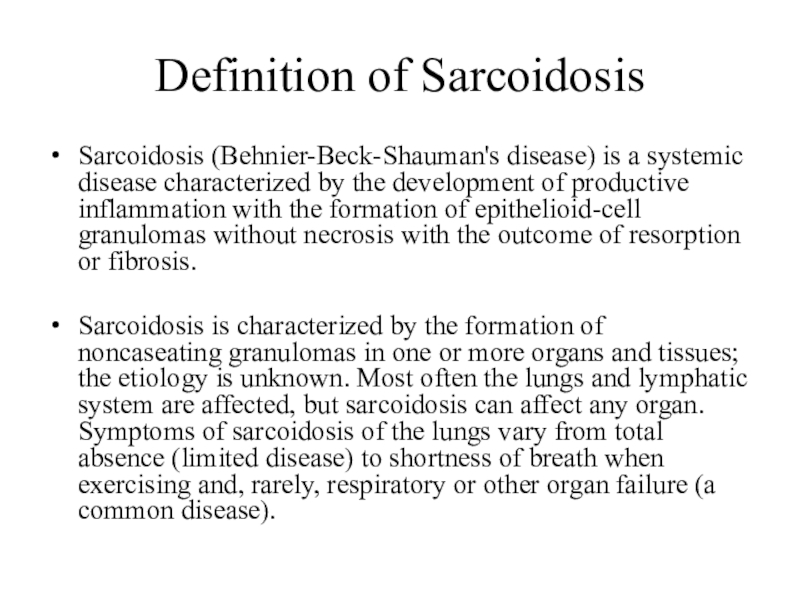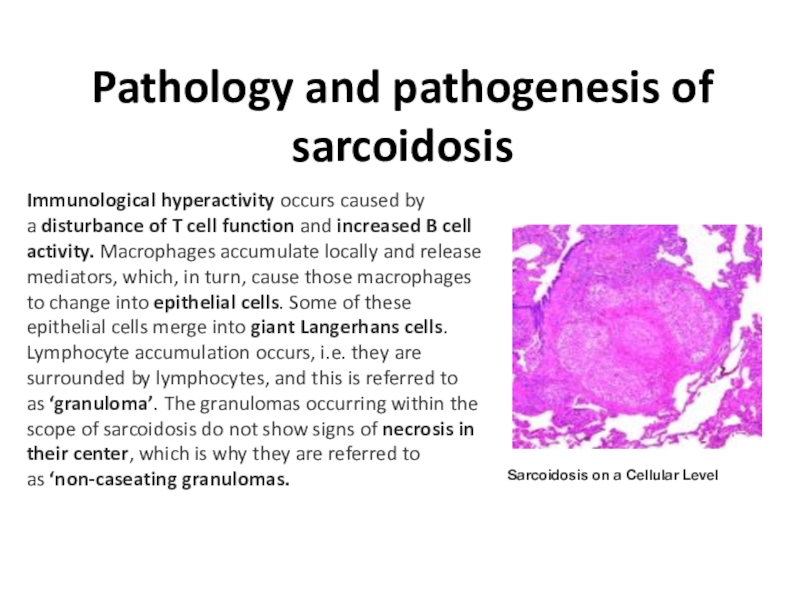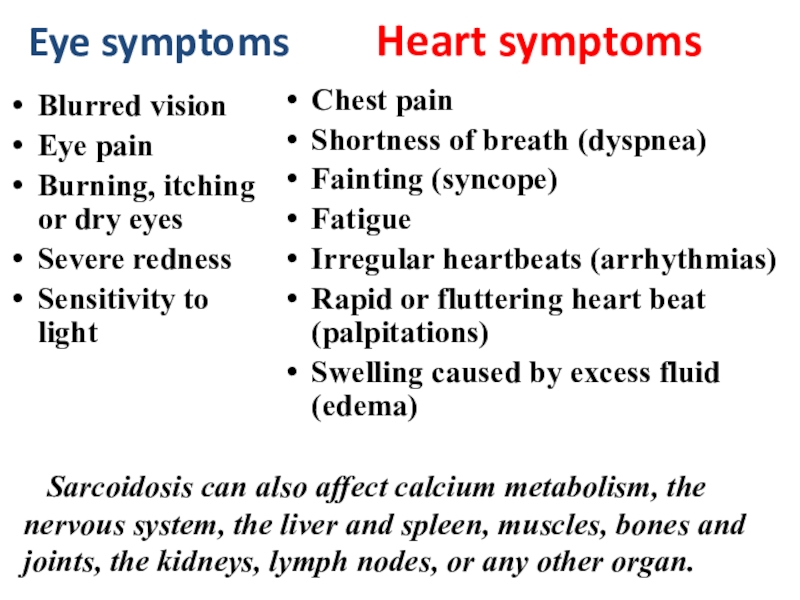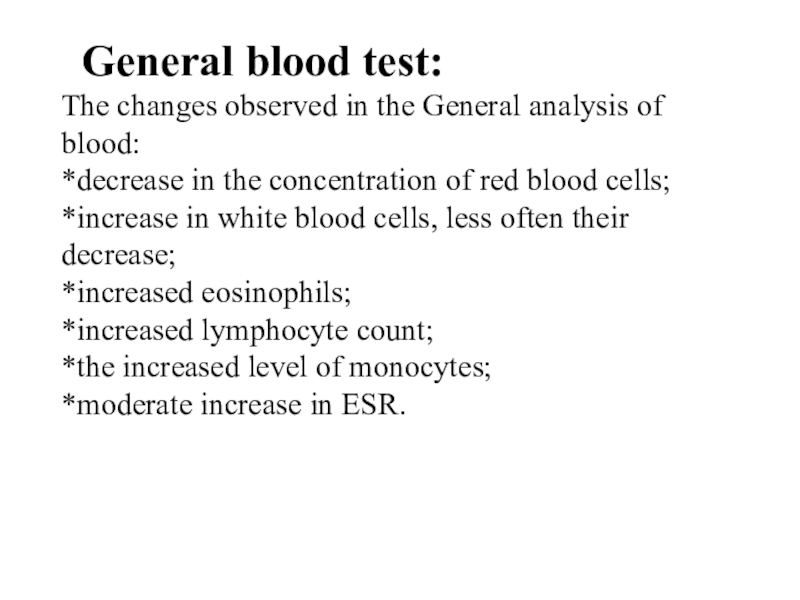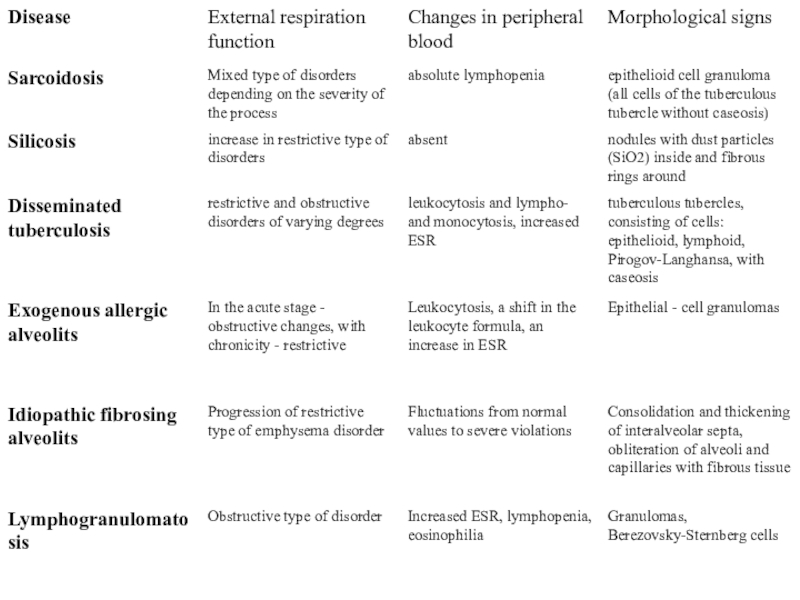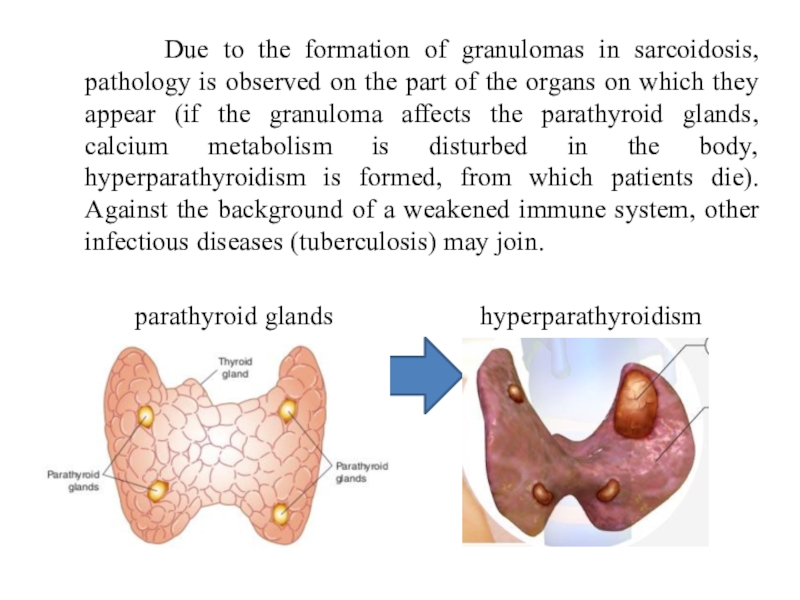Слайд 1Definition of Sarcoidosis
Sarcoidosis (Behnier-Beck-Shauman's disease) is a systemic disease
characterized by the development of productive inflammation with the formation
of epithelioid-cell granulomas without necrosis with the outcome of resorption or fibrosis.
Sarcoidosis is characterized by the formation of noncaseating granulomas in one or more organs and tissues; the etiology is unknown. Most often the lungs and lymphatic system are affected, but sarcoidosis can affect any organ. Symptoms of sarcoidosis of the lungs vary from total absence (limited disease) to shortness of breath when exercising and, rarely, respiratory or other organ failure (a common disease).
Слайд 2 Stages of chronic sarcoidosis
Слайд 3Etiology of Sarcoidosis
1. Genetics
Studies have shown that a mutation of the
gene BTNL2, as well as the HLA-DQB1 variant of the gene HLA,
are associated with an increased risk for the disease.
2. Infectious agents
The major implicated infectious agents include: mycobacteria, fungi, borrelia, and rickettsia.
Mycobacterium tuberculosis infection.
M.Tuberculosis catalase – peroxidase has been identified as a possible antigen catalyst of sarcoidosis.
The disease has also been reported by transmission via organ transplants.
3. Autoimmune
Association of autoimmune disorders has been frequently observed. The exact mechanism of this relation is not known, but some evidence supports the hypothesis that this is a consequence of Th1 lymphokine prevalence
Слайд 4Risk factors
While anyone can develop sarcoidosis, factors that may increase
your risk include:
Age. Sarcoidosis can occur at any age, but often
occurs between the ages of 20 and 60 years. Women are slightly more likely to develop the disease.
Race. People of African descent and those of Northern European descent have a higher incidence of sarcoidosis. African-Americans are more likely to have involvement of other organs along with the lungs.
Family history. If someone in your family has had sarcoidosis, you're more likely to develop the disease.
Слайд 5Pathology and pathogenesis of sarcoidosis
Sarcoidosis on a Cellular Level
Immunological hyperactivity occurs
caused by a disturbance of T cell function and increased B cell activity. Macrophages
accumulate locally and release mediators, which, in turn, cause those macrophages to change into epithelial cells. Some of these epithelial cells merge into giant Langerhans cells. Lymphocyte accumulation occurs, i.e. they are surrounded by lymphocytes, and this is referred to as ‘granuloma’. The granulomas occurring within the scope of sarcoidosis do not show signs of necrosis in their center, which is why they are referred to as ‘non-caseating granulomas.
Слайд 6. While this information may not be as relevant for the
exam, one may come across this in clinical practice where
a patient may want to know about this in more detail. Within the aforementioned giant cells, shell-shaped calcified inclusions can be found here and there, the so-called ‘Schaumann bodies’. These were named after J. N. Schaumann, who was the first to recognize that sarcoidosis is a systemic disease that can attack several organs and not only the skin, which had been the theory until that time.
Note: Histologically, in cases of sarcoidosis, non-caseating granulomas are present, while in cases of tuberculosis, the granulomas are caseating
Sarcoidosis is a multisystem disease that involves the lungs in 90 percent of cases. It has a predilection for the upper lobes of the lung and bronchovascular bundles more than other lung compartments, although it can affect any area. Lung involvement is often associated with hilar and mediastinal lymphadenopathy.
On histopathology, classic sarcoid granulomas are non-necrotizing with a tightly packed central area composed of macrophages, epithelioid cells, multinucleated giant cells, and T lymphocytes that are CD4 positive. The central areas are surrounded by CD8 and CD4 positive T lymphocytes, B lymphocytes, monocytes, mast cells, and fibroblasts, which in turn are surrounded by lamellar rings of hyaline collagen. The proportions of lymphocytic infiltrate and fibrosis surrounding the granulomas vary depending on the patient and disease duration. Additional histopathologic features of sarcoid granulomas that may be present include asteroid bodies, Schaumann bodies, and birefringent crystalline particles (calcium oxalate and other calcium salts.

Слайд 8C L I N I C A L
M
A N I F E S T A T I
O N S
The presentation of sarcoidosis ranges from patients who are asymptomatic to those with organ failure.
Acute sarcoidosis and chronic sarcoidosis are two distinct manifestations of the disease, where acute sarcoidosis does not necessarily precede chronic sarcoidosis.
Acute sarcoidosis (approx. ⅓ of cases)-typically has a sudden onset and remits spontaneously within approx. 2 years
Chronic sarcoidosis (approx. ⅔ of cases)-in rare cases, preceded by acute sarcoidosis
Слайд 9
Respiratory complaints including
cough and dyspnea are the
most common presenting symptoms. In many cases, the patient presents
with a 2- to 4-week history of these symptoms.
Symptoms related to cutaneous and ocular
disease are the next two most common complaints. Skin lesions are often nonspecific.
Nonspecific constitutional symptoms include
fatigue, fever, night sweats, and weight loss. Fatigue is perhaps the most common constitutional symptom that affects these patients.
Слайд 10Lung symptoms
Lung involvement occurs in >90 % of
sarcoidosis patients and may cause lung problems, such as:
Persistent dry
cough is a very common symptom. Airway
hyperreactivity, as determined by methacholine challenge, will be positive in some of these patients.
Shortness of breath
Wheezing
Chest pain
Pulmonary arterial hypertension is reported in at least 5%
of sarcoidosis patients. Either direct vascular involvement or the consequence of fibrotic changes in the lung can lead to pulmonary arterial hypertension.
Слайд 11Skin symptoms
Skin involvement is eventually identified in over a
third of patients with sarcoidosis.
The classic cutaneous lesions include
erythema
nodosum, maculopapular lesions, hyper- and hypopigmentation, keloid formation, and subcutaneous nodules. A specific complex of involvement of the bridge of the nose, the area beneath the eyes, and the cheeks is referred to as lupus pernio and is diagnostic for a chronic form of sarcoidosis.
The maculopapular lesions from sarcoidosis are the most common chronic form of the disease and they are not painful and indurated. They can become confluent and infiltrate large areas of the skin. With treatment, the color and induration may fade.
Слайд 12Eye symptoms
Blurred vision
Eye pain
Burning, itching or dry eyes
Severe redness
Sensitivity to
light
Chest pain
Shortness of breath (dyspnea)
Fainting (syncope)
Fatigue
Irregular heartbeats (arrhythmias)
Rapid or fluttering
heart beat (palpitations)
Swelling caused by excess fluid (edema)
Heart symptoms
Sarcoidosis can also affect calcium metabolism, the nervous system, the liver and spleen, muscles, bones and joints, the kidneys, lymph nodes, or any other organ.
Слайд 13Laboratory diagnostics
In case of suspicion, the patient is prescribed a
General and biochemical blood test, a urine test.
Preparation for laboratory
diagnostics:
*Alcohol and smoking are excluded 24 hours before the study;
*blood and urine sampling is performed in the morning before meals;
*some medications are canceled within a few days.
Слайд 14 General blood test:
The changes observed in the General analysis
of blood:
*decrease in the concentration of red blood cells;
*increase in
white blood cells, less often their decrease;
*increased eosinophils;
*increased lymphocyte count;
*the increased level of monocytes;
*moderate increase in ESR.
Слайд 15 Biochemical analysis
Specific
changes:
*Angiotensin-converting enzyme. The level is significantly increased, the norm is
from 17 to 60 units/l. Venous blood is taken for the study.
*Calcium. Granulomas in the disease actively produce vitamin D, which affects the exchange of calcium. The level of the substance increases significantly, the deviation is considered to be higher than 2.5 mmol/l.
*Tumor necrosis factor alpha. The substance takes part in the formation of granulomas. In the exchange of this substance, macrophages and monocytes are involved, the number of which increases significantly with the disease. Patients have a General increase in the concentration of this protein.
*Test Kveim-Sulzbach. The analysis confirms the disease. The patient is subcutaneously injected with infected lymphatic tissue. When the disease occurs, a bubble appears above the skin.
*Tuberculin test. In sarcoidosis, this test is negative in 90% of people. The drug is administered subcutaneously. If the result is positive.
*Copper. With pathology, the level of this substance increases. At the same time, the level of ceruloplasmin rises.

Слайд 16
Acute sarcoidosis:
↑ Inflammatory markers
Findings typical for sarcoidosis are absent (e.g.,
↑ ACE, ↑ IgG, ↑ calcium)
Chronic sarcoidosis:
↑ Calcium due to
elevated levels of 1,25-(OH)2-vitamin D3
↓ CD4+ T cells: T helper cells are consumed during granuloma formation → CD4+ levels are low in serum and high in bronchoalveolar lavage.
↑ IgG (approx. 50% of patients)
↑ Angiotensin-converting enzyme (ACE) blood levels; may be used to monitor disease activity and therapy
↑ Inflammatory markers, possible lymphopenia
Urine analysis: hypercalciuria
Слайд 17Instrumental investigations:
Chest x-ray
CT
Biopsy
Endoscopic examination: bronchoscopy and thoracoscopy
Pulmonary function
tests (to assess the severity of the disease)
Слайд 18Chest X-ray:
Sarcoidosis—Stage I: Bilateral hilar adenopathy in stage I
sarcoidosis
Sarcoidosis—Stage II: Bilateral hilar adenopathy with interstitial opacities in stage
II sarcoidosis.
Sarcoidosis—Stage III: Diffuse interstitial opacities without hilar adenopathy in stage III sarcoidosis.
Sarcoidosis—Stage IV: Severe, diffuse fibrosis with hilar adenopathy and cystic changes of the upper lobes in stage IV sarcoidosis.
Слайд 20CT findings in more advanced stages (II to IV) include:
Thickening
of the bronchovascular bundles and bronchial walls
Beading of the interlobular
septa
Ground-glass opacification
Parenchymal nodules, cysts, or cavities
Traction bronchiectasis
Слайд 22 When imaging suggests sarcoidosis, the diagnosis is confirmed
by demonstration of noncaseating granulomas on biopsy and exclusion of
alternative causes of granulomatous disease .
Biopsy sites:
peripheral lymph nodes;
skin lesions;
conjunctiva;
Слайд 23Biopsy methods:
Bronchoscopic:
Transbronchial lung biopsy (PLL).
Classical
transbronchial needle biopsy of intrathoracic lymph nodes
Endoscopic fine-needle puncture of
mediastinal lymph nodes under the control of endosonography.
Direct biopsy of the bronchial mucosa (direct biopsy).
Brush biopsy of the bronchial mucosa (brush biopsy).
Bronchoalveolar lavage (BAL).
Surgical biopsy techniques:
Thoracotomy with biopsy of the lung and intrathoracic lymph nodes.
Video-assisted thoracoscopy
Mediastinoscopy.
Слайд 25 Bronchoscopy:
changes in the vessels of the bronchial
mucosa (expansion)
lumpy eruptions (sarcoid granulomas) in the form of plaques
of various sizes (from millet grains to a pea);
on the mucous membrane of the bronchi, ischemic spots are visible - pale areas devoid of blood vessels.
Thoracoscopy:
Whitish-yellowish sarcoid granulomas are visible on the pleural surface.
Слайд 26Pulmonary function test:
Pulmonary function test results are often normal in early
stages but demonstrate restriction and reduced diffusing capacity for carbon
monoxide (DLco) in advanced disease.
Слайд 27Differential diagnosis
sarcoidosis
Слайд 32Treatment
NSAIDs
Corticosteroids
Sometimes used immunosuppressants
Слайд 33Patients who need treatment regardless of stage include the following:
Worsening
symptoms
Activity limitation
Significant impairment or deterioration in lung function
Significant changes on
x-rays (cavities, fibrosis, conglomerates, pulmonary hypertension)
Damage to the heart, nervous system, or eyes
Renal or hepatic impairment
Moderate to severe hypercalcemia
Disfiguring lesions of the skin or joints
For the treatment of discomfort from the musculoskeletal system, NSAIDs are used.
Слайд 34Corticosteroids
Symptom management begins with corticosteroids.
! The presence of abnormalities on
chest scans without significant symptoms or evidence of decreased organ
function is not an indication for treatment.
The standard protocol is prednisone 20–40 mg orally once a day, depending on symptoms and severity of the disease. Alternatively, you can use an every other day regimen: for example, prednisone 40 mg orally once every other day.
Although patients rarely need a dose> 40 mg / day, higher doses may be required to reduce complications of neurological disease. Response usually occurs within 6-12 weeks, so symptoms and pulmonary function tests can be re-evaluated between 6 and 12 weeks. In chronic and latent cases, the reaction may be delayed. If there is an effect, the dose of corticosteroids is gradually reduced to maintenance (for example, prednisone 10-15 mg / day); with improvement, therapy is continued for at least 6-12 months.
Слайд 35The optimal duration of treatment is unknown. A premature dose
reduction may lead to relapse. In case of a doubtful
reaction or ineffectiveness of treatment, the use of the drug is gradually discontinued. Ultimately, corticosteroids can be discontinued in most patients, but since relapse occurs in 50% of cases, follow-up examinations should be performed, usually every 3–6 months.
Treatment with corticosteroids should be resumed if complaints and symptoms recur, including dyspnea, arthralgia, fever, liver failure, cardiac arrhythmias, CNS symptoms, hypercalcemia, eye damage, lack of topical drug control, and disfiguring skin lesions. Because low doses of corticosteroids suppress ACE production, it may be useful to monitor serum ACE levels over time when assessing adherence to corticosteroid treatment in the presence of elevated ACE levels.
Слайд 36Inhaled corticosteroids can relieve cough in patients with endobronchial involvement
or airway hyperresponsiveness. Inhalation of large doses of budesonide or
fluticasone has sometimes been shown to be effective in pulmonary stages I-III, while combinations of systemic and inhaled steroids have a positive effect on both clinical symptoms and changes on radiographs in stages II-IV.
Local corticosteroids may be helpful in treating dermatitis, sinusitis, and eye diseases.
When treating with corticosteroids or immunosuppressants, prophylaxis for Pneumocystis jirovecii pneumonia should be considered.
Слайд 37Immunosuppressants
! Treatment with immunosuppressants is carried out in case of
intolerance to moderate doses of corticosteroids, refractoriness of sarcoidosis to
corticosteroids, or if treatment with corticosteroids is required for a long time.
In about 10% of cases when therapy is necessary, tolerated doses of corticosteroids are ineffective, and a 6-month trial of methotrexate therapy at a dose of 10-15 mg / week should be carried out. Methotrexate and corticosteroids are given initially; after 6-8 weeks, the dose of corticosteroids can be gradually reduced, and in many cases their use can be discontinued. However, the maximum effect of methotrexate can be observed after 6-12 months. In such cases, the dose of prednisolone should be decreased more slowly. Determination of blood corpuscles and liver enzymes should be performed first every 1–2 weeks, then every 4–6 weeks, as soon as a stable dose is reached. In patients receiving methotrexate, folate (1 mg orally per day) is recommended.
Слайд 38Other drugs that have been effective in a small number
of patients who do not respond to corticosteroid treatment or
who experience complicating side effects include azathioprine, mycophenolate mofetil, cyclophosphamide, chloroquine or hydroxychloroquine, and infliximab. Immunosuppressants are often more effective in refractory cases, and relapse is common after stopping treatment. The TNF inhibitor infliximab may be effective in treating chronic steroid-dependent pulmonary sarcoidosis, refractory lupus fever, and neurosarcoidosis. It is administered intravenously at a dose of 3-5 mg / kg once, repeated in 2 weeks, and then administered 1 time / month.
Hydroxychloroquine 400 mg orally once a day or 200 mg orally twice a day may be as effective for treating hypercalcemia, sarcoid skin lesions, or enlarged patient-discomfortable or disfiguring peripheral lymph nodes.
Слайд 39Oxygen therapy
The administration of oxygen to patients with LH
on the background of sarcoidosis is indicated for chronic hypoxemia
(Rao2 < 55 mm Hg), while the dose is titrated to reach SpO2 >90% when breathing through an oxygen concentrator
Specific LH therapy for sarcoidosis
Currently, there are effective drugs for the treatment of pulmonary arterial hypertension (PAH), such forms as idiopathic (primary) PAH, PAH in systemic scleroderma, etc. It is possible that these same drugs are also the most effective therapy for LH associated with sarcoidosis.
Слайд 40Surgery
Organ transplant may be considered if sarcoidosis has severely damaged
your lungs, heart or liver.
Слайд 41Complication of sarcoidosis:
Complications list for Sarcoidosis:
Lung damage - about 90%
of cases
Collapsed lung
Lung granulomas
Lung fibrosis
Frequent pneumonia
Bleedings
Eye complications:
Cataracts
Glaucoma
Blindness
Heart damage
Nervous system -
only about 1-5% of cases.
Liver damage
Death
Kidney damage
Arthritis
Psychological problem
Слайд 42Collapsed lung
inflammation or the growth of granulomas
rupture of pleura
the
pressure is equalized with atmospheric pressure
the lungs begin to shrink
Слайд 43Pulmonary fibrosis
Pulmonary fibrosis is the end
stage of pulmonary sarcoidosis. This process begins at stages 2
- 3 of the disease, when symptoms are just beginning to appear
Слайд 44 Due to the formation of granulomas
in sarcoidosis, pathology is observed on the part of the
organs on which they appear (if the granuloma affects the parathyroid glands, calcium metabolism is disturbed in the body, hyperparathyroidism is formed, from which patients die). Against the background of a weakened immune system, other infectious diseases (tuberculosis) may join.
parathyroid glands hyperparathyroidism
